Massage oils can elevate your self-care routine to new heights. These oils, infused with essential oils, offer numerous benefits for your well-being. They can reduce stress, relieve muscle tension, and soothe your mind and body.
Aromatherapy massage blends essential oils with traditional techniques for enhanced healing. Plant-derived essential oils possess unique properties that address specific health concerns. These oils can improve sleep, manage pain, and help you unwind after a long day.
Various types of massage oils cater to different needs. Lavender soothes, while peppermint energizes. Understanding the science behind these oils helps you choose the perfect blend.
This guide will inspire you to incorporate massage oils into your wellness routine. Whether you’re experienced or new to massage, you’ll find valuable insights here.
Key Takeaways
- Aromatherapy massage combines essential oils with massage for enhanced benefits
- Essential oils, derived from plants, offer unique healing and cleansing properties
- Massage oils can reduce stress, relieve muscle tension, and improve sleep quality
- Choosing the right massage oil depends on your specific needs and preferences
- Incorporating massage oils into your self-care routine promotes holistic wellness
Introduction to Massage Oils and Their Benefits
Massage oils enhance the therapeutic effects of massage. These natural oils soothe sore muscles, nourish skin, and promote relaxation. Essential oils are often added for aromatherapy benefits.
The U.S. massage industry generates an estimated $16 billion annually. Popular oils include jojoba, sweet almond, and sunflower. These oils moisturize and reduce friction during massage.
Massage oils offer numerous benefits. They promote relaxation, nourish skin, and relieve muscle tension. They also improve flexibility, enhance sleep, and boost circulation.
- Deep relaxation and stress reduction
- Nourishment and hydration for the skin
- Relief from muscle tension and soreness
- Improved flexibility and joint mobility
- Enhanced sleep quality
- Improved circulation and detoxification
- Emotional well-being and bonding
When selecting a massage oil, consider skin type, allergies, and desired aromatherapy effects. Base oils like almond and jojoba are common choices. Essential oils can add specific therapeutic properties.
“Massage therapy is a powerful tool for promoting physical and emotional well-being, and the use of high-quality massage oils can greatly enhance its benefits.” – Dr. Sarah Thompson, Naturopathic Physician
Safety is crucial when using massage oils. Always perform a patch test before applying a new oil. Be aware of allergies and sensitivities. Pregnant women should consult healthcare professionals before using essential oils.
Types of Massage Oils and Their Unique Properties
Massage oils offer various benefits and properties. Each type can help achieve different outcomes, from relaxation to energy boosts. Let’s explore popular massage oils and their distinct characteristics.
Lavender Oil: The Calming Classic
Lavender oil is known for its calming and relaxing properties. Its soothing aroma can reduce stress and anxiety while promoting better sleep quality. Many use it before bedtime to create a tranquil atmosphere.
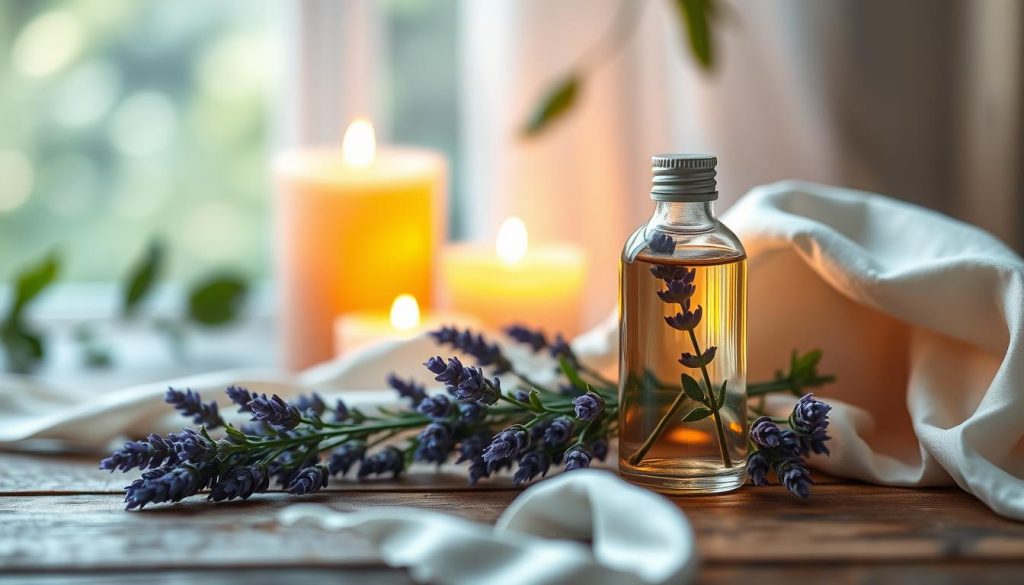
Lavender oil also offers skin benefits. It’s gentle and suitable for most skin types, nourishing and moisturizing during massage. Its anti-inflammatory properties can soothe irritated skin, making it ideal for sensitive skin.
Jasmine Oil: Enhancing Romance and Luxury
Jasmine oil is renowned for its romantic and luxurious properties. Its sweet, floral aroma evokes feelings of love and passion. It’s perfect for couples’ massages or creating a romantic atmosphere.
Jasmine oil also improves skin elasticity and reduces fine lines. It promotes a healthy, radiant complexion. After a massage, your skin will feel soft, smooth, and rejuvenated.
Lemongrass Oil: Energizing and Uplifting
Lemongrass oil refreshes and energizes. Its citrusy, herbal scent uplifts mood and improves focus. It combats fatigue and mental exhaustion, promoting clarity and alertness.
Lemongrass oil also offers therapeutic benefits. It relieves muscle pain and soreness with its anti-inflammatory properties. Athletes find it beneficial for soothing tired muscles and promoting faster recovery.
| Massage Oil | Key Properties | Benefits |
|---|---|---|
| Lavender Oil | Calming, relaxing | Reduces stress, promotes sleep, soothes skin |
| Jasmine Oil | Romantic, luxurious | Enhances intimacy, improves skin elasticity |
| Lemongrass Oil | Energizing, uplifting | Boosts mood, relieves muscle pain, promotes clarity |
Essential Oils vs. Carrier Oils: What’s the Difference?
Essential oils are concentrated plant extracts obtained through distillation or cold pressing. These potent oils boast distinct aromas and therapeutic properties, including anti-inflammatory and antimicrobial effects. Their high concentration makes them powerful healing agents.
Carrier oils come from fatty plant parts like seeds, kernels, or nuts. Less concentrated than essential oils, they serve as dilution mediums. These oils nourish and hydrate skin while enhancing essential oils’ benefits during massage.
Essential oils require dilution due to their potency. Mixing them with carrier oils reduces skin irritation risks. Dilution ratios vary by purpose, ranging from 0.5% to 10% essential oils. Carrier oils make up the remainder.
| Carrier Oil | Therapeutic Properties |
|---|---|
| Coconut Oil | Antimicrobial properties due to high lauric acid content |
| Black Cumin Seed Oil | Anti-inflammatory, antibacterial, and antifungal |
| Jojoba Oil | Natural anti-inflammatory properties, suitable for oily or acne-prone skin |
| Evening Primrose Oil | May enhance quality of life for multiple sclerosis patients and help with eczema symptoms |
| Rosehip Oil | Rich in essential fatty acids, beneficial for relaxation and reducing anxiety |
| Grapeseed Oil | Antioxidant and antimicrobial properties, leaves a glossy film on the skin |
Choose carrier oils based on skin type, absorption rate, and therapeutic properties. Jojoba oil suits oily or acne-prone skin with its anti-inflammatory qualities. Rosehip oil, rich in fatty acids, aids relaxation and anxiety reduction.
Understanding essential and carrier oils allows for personalized massage blends. This knowledge ensures a safe, effective massage experience tailored to your unique needs and preferences.
How to Choose the Right Massage Oil for Your Needs
Selecting the ideal massage oil requires careful consideration of several factors. Your skin type and potential sensitivities play a crucial role in this decision. Understanding these aspects will help you avoid discomfort during your massage session.
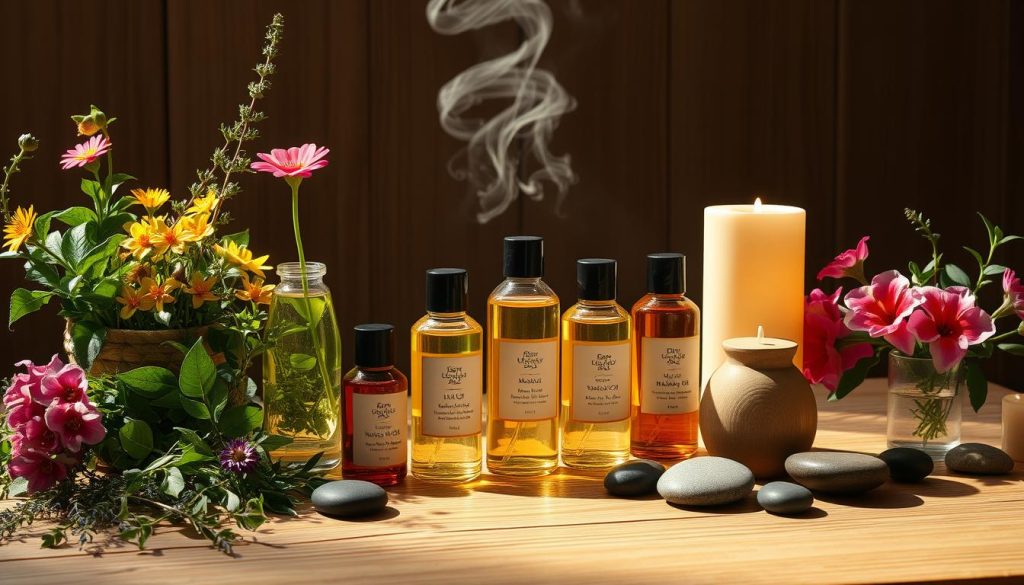
After identifying skin-safe oils, consider the aromatherapy benefits you desire. Essential oils offer unique properties that enhance your massage experience. Lavender oil, for instance, promotes relaxation and stress relief. Lemongrass oil, with its invigorating scent, can boost mood and improve focus.
Consider Your Skin Type and Sensitivities
Choosing a suitable massage oil for your skin type is essential. Sweet almond oil works well for all skin types. Coconut oil moisturizes and solidifies at cooler temperatures.
Jojoba oil suits sensitive or acne-prone skin. Grapeseed oil absorbs easily without leaving residue. Olive oil, being thicker, is ideal for deep tissue massages.
- Sweet almond oil is suitable for all skin types.
- Coconut oil has moisturizing properties and solidifies at cooler temperatures.
- Jojoba oil is recommended for people with sensitive or acne-prone skin.
- Grapeseed oil is easily absorbed and doesn’t leave a heavy residue on the skin.
- Olive oil is thicker and suitable for deep tissue and sports massages.
Check ingredient lists carefully if you have allergies. Perform a patch test on a small skin area before using a new oil. This precaution ensures compatibility and prevents potential reactions.
Determine Your Desired Aromatherapy Benefits
Consider the specific aromatherapy benefits you seek during your massage. Essential oils offer unique properties that can enhance your experience. They provide targeted relief for various concerns.
- Lavender oil is calming and relaxing, aiding in stress reduction and better sleep.
- Eucalyptus oil relieves muscle tension and clears airways.
- Arnica oil is preferred for sports massages due to its anti-inflammatory properties.
- Sesame oil offers a warming sensation and is rich in antioxidants.
- Chamomile oil is soothing and perfect for sensitive skin or skin irritations.
Carefully assess your skin type, sensitivities, and desired aromatherapy benefits. This approach helps you select the perfect massage oil. It elevates your massage experience and promotes overall wellness.
The Science Behind Massage Oils and Their Therapeutic Effects
At Best Butik Massage, carefully selected oils enhance therapeutic effects. These oils possess unique properties like anti-inflammatory and analgesic effects. They help relieve muscle tension, pain, and inflammation during massages.
Carrier oils form the base of massage oil blends. Their viscosity varies based on massage type and desired skin benefits. Grapeseed oil, thin and light, suits deep tissue massages. Avocado oil, rich in fatty acids, provides a luxurious feel.
| Carrier Oil | Viscosity | Benefits |
|---|---|---|
| Grapeseed Oil | Very Thin | Deep tissue and sports massage |
| Sweet Almond Oil | Lightweight | Rich in vitamin E, nourishing for most skin types |
| Jojoba Oil | Similar to skin oils | Non-greasy, suitable for all skin types |
| Avocado Oil | Thick | Rich in essential fatty acids and vitamins, luxurious feel |
Essential oils added to carriers offer targeted therapeutic effects. Lavender oil calms, reduces anxiety, and relieves muscle tension. Peppermint oil cools, eases headaches, and soothes sore muscles. Research shows inhaling lavender oil can reduce cortisol, the stress hormone.
For safety and optimal absorption, essential oils are diluted in carrier oils. Experienced therapists create custom blends tailored to clients’ needs. This combination provides a personalized massage experience with targeted relief.
“The art of blending essential oils with carrier oils is key to unlocking the full potential of massage therapy, providing targeted relief and overall well-being.”
Understanding massage oil science helps appreciate the expertise in each session. This knowledge ensures maximum benefits for your body and mind during therapy.
Massage Oils and Their Healing Properties
Massage oils offer incredible healing properties that can transform your body and mind. When combined with essential oils, they provide deep relaxation and reduce muscle tension. These oils can boost your immune system and alleviate stress and anxiety.
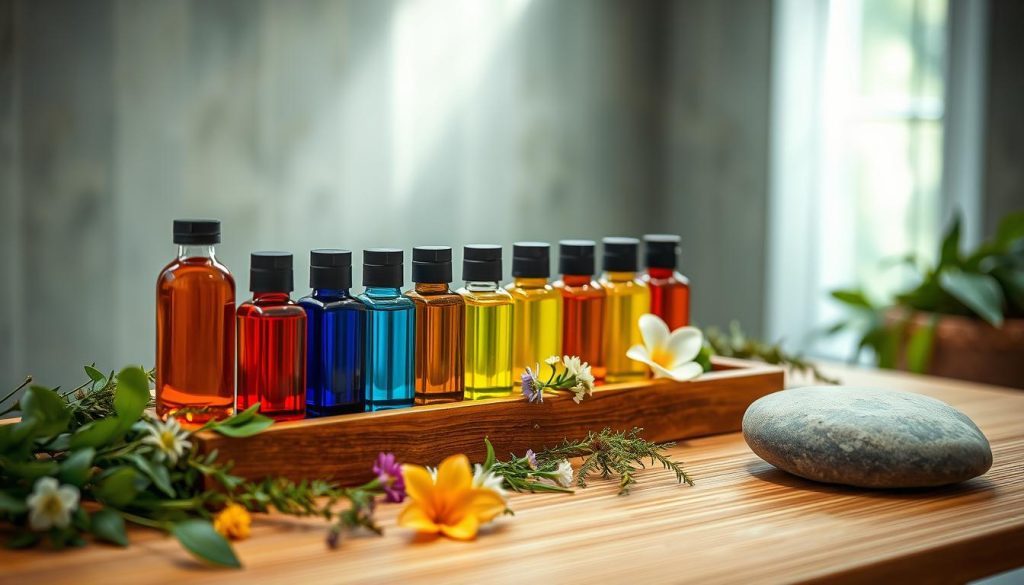
Carrier oils offer specific benefits for various needs. Sesame oil relieves joint pain, while sweet almond oil with rose oil prevents skin aging. Coconut oil treats sunburns, and olive oil strengthens muscles and suits baby massages.
Aromatherapy massage with essential oils enhances healing effects. Lavender promotes relaxation, while geranium eases menstruation and menopause symptoms. Bergamot soothes muscle spasms and digestive issues, and ylang-ylang treats depression.
- Lavender essential oil for relaxation
- Geranium essential oil for menstruation and menopause symptoms
- Bergamot essential oil for soothing muscle spasms and digestive issues
- Ylang-ylang essential oil for treating depression
- Clary sage essential oil as a muscle relaxant and for PMT relief
- Chamomile essential oil for its anti-inflammatory and mind-soothing properties
- Patchouli essential oil for grounding, toning, and rejuvenating
- Lemongrass essential oil for its energizing and cleansing properties, as well as muscle ache relief
- Eucalyptus essential oil for its antiseptic properties and promoting clear breathing
- Orange essential oil for uplifting and revitalizing, helpful for lack of energy or depression
Massage alone can decrease stress, soothe anxiety, and release muscle tension.
Always use a carrier oil when applying essential oils to avoid skin reactions. Almond oil moisturizes and improves circulation, while argan oil strengthens nails and treats split ends. Castor oil seals in moisture and promotes hair growth.
Coconut oil benefits dry skin and fights aging. Jojoba oil acts as a natural moisturizer with anti-inflammatory effects. Grapeseed oil absorbs easily and helps prevent acne.
Incorporating Massage Oils into Your Self-Care Routine
Massage oils can revolutionize your self-care routine. Aromatherapy and essential oils elevate your self-massage experience. Various scents cater to different needs, from calming lavender to invigorating peppermint.
Studies show 65% of people use essential oils like lavender or peppermint in their massage routine. 40% create custom blends, highlighting a trend towards personalized self-care.
Self-Massage Techniques with Essential Oils
Self-massage techniques target specific areas of tension. Focus on easy-to-reach spots like the neck, shoulders, hands, and feet. 75% of people report reduced stress after using essential oils in massage sessions.
Creating a Relaxing Atmosphere with Diffusers
Diffusers create a calming ambiance by dispersing essential oil aromas. They transform your space into a tranquil oasis. 55% of individuals choose alternative therapies like aromatherapy massages or reflexology.
“Aromatherapy is a caring, hands-on therapy which seeks to induce relaxation, to increase energy, to reduce the effects of stress and to restore lost balance to mind, body and soul.” – Robert Tisserand
Adding Massage Oils to Your Bath for Ultimate Relaxation
A relaxing bath with massage oils is the ultimate self-care indulgence. Warm water and essential oils melt away stress and tension. 80% of people report improved emotional well-being after relaxing massages with essential oils.
Massage Oil Blends for Specific Health Concerns
Targeted massage oil blends can address various health issues effectively. Combining essential oils creates powerful blends for stress relief, muscle pain relief, and immune system boosting. The magic of massage oils lies in their synergistic ability to promote relaxation and well-being.
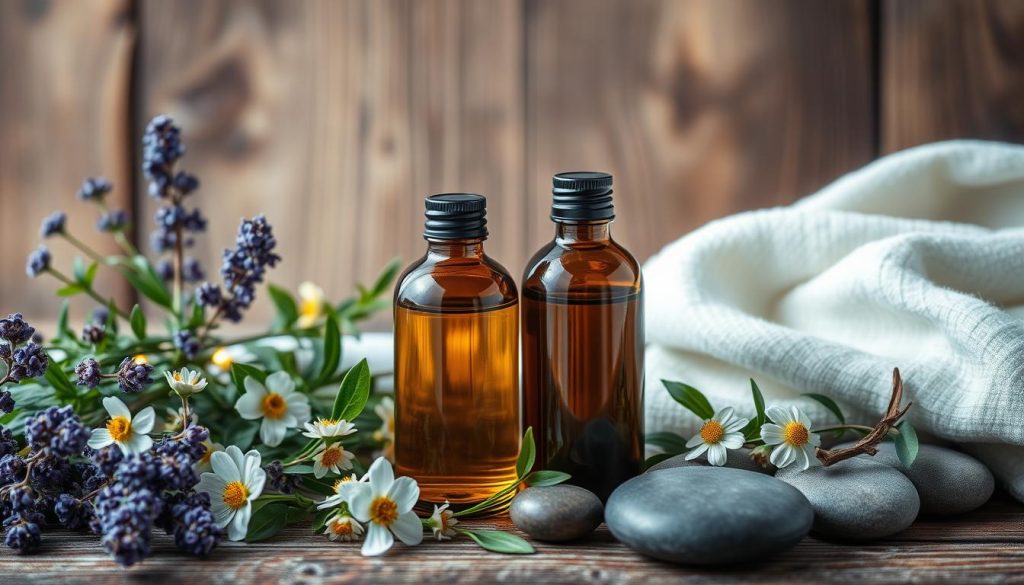
Aromatherapy helps with various health concerns through direct inhalation and massage. It can alleviate nausea, bodily aches, anxiety, stress, depression, fatigue, and insomnia. Additionally, it may provide relief for muscle pains, headaches, menstrual problems, menopausal issues, and digestive problems.
Stress Relief Blend
Combine lavender and bergamot essential oils for a soothing stress relief blend. Lavender oil has sedative, anti-inflammatory, anti-fungal, and antibacterial properties. It aids in relaxation and improves sleep. Bergamot’s uplifting scent helps melt away stress and promote calm.
Muscle Pain Relief Blend
Peppermint and eucalyptus oils create a powerful muscle pain relief blend. Peppermint oil’s cooling and analgesic properties benefit headaches, muscle pain, and joint pain. Eucalyptus oil clears sinuses and promotes deeper breathing, enhancing relaxation.
Immune-Boosting Blend
Frankincense and tea tree oils form an effective immune-boosting blend. Tea tree oil has antimicrobial capabilities for wound care and infections. Frankincense has been used for centuries to promote overall health. Together, these oils can strengthen your body’s natural defenses.
“A combination of scents can be used during a massage session, such as lavender to induce relaxation at the beginning, eucalyptus to clear sinuses when the client turns over and peppermint to help the client feel more alert at the end of the session.”
Consult health care providers or NHPC-recognized aromatherapy practitioners for safe and effective essential oil use. With proper guidance and high-quality oils, you can harness massage oil blends’ power. These blends can promote health and well-being in your daily life.
The Role of Massage Oils in Professional Massage Therapy
Professional massage therapists use high-quality oils to enhance therapeutic benefits. These oils come in three main categories: essential oils, carrier oils, and blended massage oils. Each type has unique properties that contribute to a rejuvenating experience.
Essential oils are concentrated plant extracts with therapeutic properties. Therapists carefully dilute these potent oils for safe and effective use. Carrier oils, like sweet almond or jojoba, dilute essential oils and moisturize skin.
Blended massage oils combine essential and carrier oils. Therapists craft these blends based on clients’ needs and preferences. They consider therapeutic outcomes, skin compatibility, and potential allergies. This tailored approach ensures maximum benefits and a personalized experience.
Oil texture and viscosity impact the massage experience. Therapists choose oils that complement specific techniques and provide optimal glide. They may recommend certain oils for targeted areas with higher absorption rates.
Professional therapists prioritize high-quality oils free from harmful ingredients. They select products without parabens, sulfates, and synthetic fragrances. Choosing a certified therapist ensures you receive the full benefits of massage oils.
DIY Massage Oil Recipes for Home Use
Crafting your own massage oil blends at home allows for a personalized touch. Mix essential oils with carriers like jojoba or grapeseed to explore various scents and benefits. This customization helps you find the ideal blend for your specific needs.
DIY recipes typically use 65 to 96 drops of essential oils. Follow proper dilution guidelines for safety and effectiveness. For adults, use a 2% rate: 10-12 drops per 1 oz bottle. For children 5-12, sensitive skin, pregnant, or breastfeeding women, use a 1% rate: 5-6 drops per 1 oz.
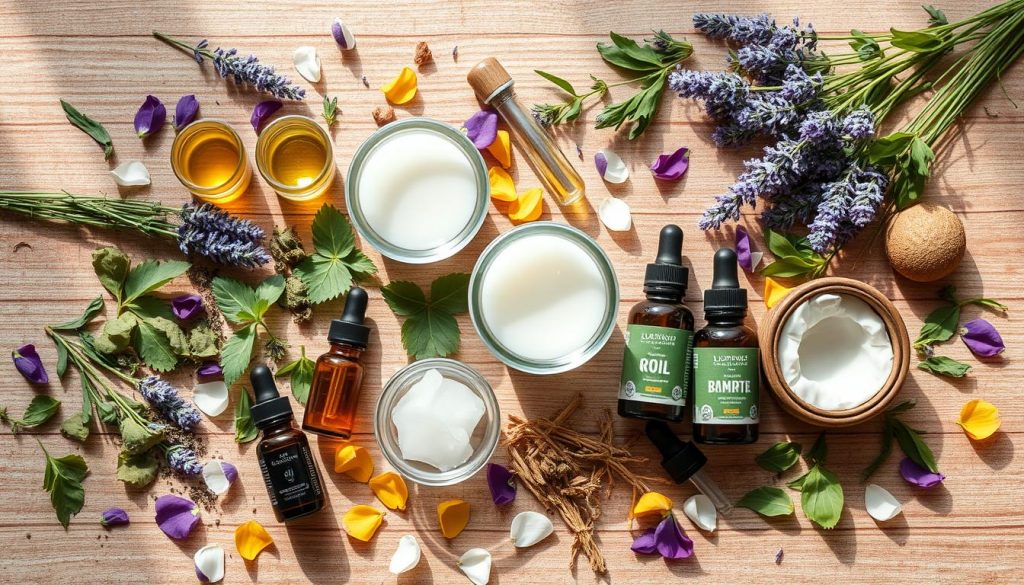
Choose carrier oils like kukui nut, jojoba, sunflower, olive, or MCT coconut oil. Sweet almond, shea nut, calendula, and arnica oils are also great options. Each carrier offers unique skin benefits. Grapeseed oil, for instance, regenerates and nourishes sun-damaged and dry skin.
Try this Dreamy Hemp Blend for Sleep recipe:
- 32 drops of organic hemp essential oil
- 32 drops of organic benzoin resin oil
- 24 drops of organic bergamot essential oil
- 8 drops of organic blue chamomile essential oil
Enhance texture by replacing one ounce with pomegranate or cranberry seed oil. Add Non-GMO Verified vitamin E oil to extend shelf life. Properly stored, DIY massage oils can last up to a year.
| Essential Oil | Therapeutic Properties |
|---|---|
| Lavender | Relaxation, stress reduction |
| Bergamot | Uplifting, stress relief |
| Peppermint | Energizing, pain relief |
| Clary Sage | Hormone balancing, relaxation |
Experiment with various essential oil blends and carrier oils to create tailored massage oils. These DIY recipes offer natural solutions for relaxation, stress relief, and muscle soothing. Discover the perfect combination to meet your unique preferences and needs.
Precautions and Safety Tips When Using Massage Oils
Prioritizing safety when using massage oils is crucial. By following key precautions, you can ensure a pleasant experience without unwanted side effects. This approach helps maximize benefits while minimizing risks.
Inform your massage therapist about health conditions, allergies, or sensitivities. This is vital for those with high blood pressure, skin issues, or chronic pain. Your therapist can then customize the session to your needs.
During pregnancy, avoid certain essential oils like rosemary or clary sage. Your therapist can recommend safe alternatives that are suitable for expectant mothers.
Proper Dilution Ratios
Proper dilution of essential oils is critical for safe use. Never apply them directly to skin; always mix with a carrier oil. Keep concentrations below 5%, with specific guidelines varying by age and health.
- Adults: 2-5% dilution (2-5 drops of essential oil per teaspoon of carrier oil)
- Children over 2 years old: 0.5-2.5% dilution
- Infants and children under 2 years old: Consult a healthcare professional before use
Popular oils needing dilution include bay, cinnamon, clove, citronella, oregano, and thyme. Following proper ratios minimizes skin irritation risks while preserving benefits.
Patch Testing for Allergies
Conduct a patch test before using new massage oils. Apply a small amount to your inner elbow or wrist. Wait 24-48 hours for any reactions.
If redness, itching, or irritation occurs, stop use immediately. Wash the area with water to alleviate any discomfort.
Be aware of photosensitivity risks with certain oils. Citrus oils can increase sun sensitivity. Avoid direct sunlight after applying these oils.
For personalized guidance, consult a professional aromatherapist or healthcare provider. They can offer advice tailored to your individual needs and health status.
By following these precautions, you can safely enjoy massage oils. Whether in self-care or professional therapy, prioritizing safety ensures a positive experience.
Massage Oils and Aromatherapy: A Perfect Combination
Lavender’s soothing scent fills the air as you relax for a massage. Massage oils and aromatherapy create a powerful synergy, enhancing overall well-being. Essential oils inhaled through nasal receptors prompt a calming effect on the brain’s limbic system.
Aromatherapy has been practiced since 2000 B.C., showcasing its enduring effectiveness for healing. Essential oils in massages have gained popularity due to their mental and emotional benefits. They stimulate brain neurotransmitters, improving mood, mental clarity, and pain management.
The Benefits of Aromatherapy Massage
Aromatherapy massages offer physical, emotional, and mental benefits for holistic healing. They reduce anxiety, depression, insomnia, nausea, and pain. Oils like sandalwood and grapefruit improve circulation, while citrus scents enhance mood.
Lavender, peppermint, eucalyptus, chamomile, and rosemary relieve headaches and reduce pain. These oils target specific muscle and ligament needs, reducing body aches and relieving stress.
- Reducing anxiety, depression, insomnia, nausea, and pain
- Improving circulation with oils like sandalwood, juniper berry, and grapefruit
- Enhancing mood with uplifting scents like orange and citrus oils
- Relieving headaches and reducing pain with lavender, peppermint, eucalyptus, chamomile, and rosemary
- Targeting specific muscle and ligament needs to reduce body aches and relieve stress
Popular Essential Oils for Aromatherapy Massage
Essential oils serve specific wellness purposes, such as uplifting, calming, energizing, and pain relief. Popular oils used in aromatherapy massage include lavender, peppermint, eucalyptus, ylang-ylang, and chamomile.
| Essential Oil | Benefits |
|---|---|
| Lavender | Relaxation, stress relief, pain reduction |
| Peppermint | Headache relief, energy boost, muscle pain relief |
| Eucalyptus | Decongestion, pain relief, mental clarity |
| Ylang-ylang | Stress relief, mood enhancement, headache relief |
| Chamomile | Relaxation, inflammation reduction, pain relief |
Aromatherapy in massage therapy sessions offers a deeper level of relaxation and healing. Soothing touch and carefully selected essential oils help achieve balance and well-being. You’ll feel refreshed and rejuvenated after this powerful combination.
Choosing High-Quality, Pure Massage Oils
Quality and purity are crucial when selecting massage oils. High-quality oils offer maximum therapeutic benefits and minimize adverse reactions. Seek pure essential oils that are organic and therapeutic grade, without synthetic additives or fillers.
Trustworthy brands disclose their sourcing and extraction methods. This transparency helps you make informed decisions. A 2018 study showed the effectiveness of carrier and essential oil blends in soothing sore muscles and joints.
- Allergies to nuts or specific fragrances
- Cost per ounce for cost-effectiveness
- Manufacturing practices, country of origin, and production processes
- Shelf life and proper storage to maintain quality
- Potential greasiness and staining on clothing
Lavender essential oil, known for its relaxation properties, has shown evidence of promoting relaxation.
Perform a patch test before using new massage oils to prevent allergic reactions. Properly dilute essential oils with carrier oils to avoid skin irritation. Steer clear of eye contact and stop using if adverse reactions occur.
| Essential Oils | Carrier Oils | Blended Massage Oils |
|---|---|---|
| Lavender (calming and relaxing) | Sweet Almond Oil | Harmonious blend of scents and therapeutic properties |
| Peppermint (invigorating and muscle tension relief) | Jojoba Oil | Tailored for specific massage techniques |
| Rosemary (pain relief) | Coconut Oil | Enhances relaxation and stress relief effects |
Choose high-quality, pure massage oils based on your needs and preferences. This approach will enhance your massage experience and maximize therapeutic benefits. Consider factors like scent, texture, and intended use when making your selection.
Massage Oils Through History: Ancient Traditions to Modern Day
Massage oils have a rich history spanning millennia, rooted in ancient civilizations worldwide. India pioneered massage therapy around 3000 BCE, followed by China in 2700 BCE. These ancient traditions recognized oils’ therapeutic properties in massage.
Ayurveda in India used massage oils for holistic healing. Practitioners believed specific oils could balance the body’s three energies, or doshas. Traditional Chinese medicine used oils to stimulate acupressure points and promote qi flow.
By 2500 BCE, massage therapy reached Egypt. Greek athletes used massage oils between 800 and 700 BCE for performance and recovery. Romans adopted fragrant oils in their bathhouses and massage practices.
“The use of aromatherapy massage and the application of essential oils to the skin is one of the easiest ways to achieve therapeutic benefits both physically and psychologically.” – Robert Tisserand, aromatherapy expert
Massage therapy declined in the West during the 17th century but resurged in the 1800s. The Swedish Movement Cure, a precursor to Swedish massage, emerged in the early 1800s. By the late 1800s, “masseur” and “masseuse” became common terms.
Massage oils remain crucial in modern spa treatments and holistic wellness practices. Essential oils in massage have gained popularity over the last 30 years. Research continues to validate their effectiveness in promoting relaxation and overall well-being.
The Future of Massage Oils: Emerging Trends and Innovations
The massage oil industry is experiencing rapid growth and innovation. With a global market size of USD 3.21 billion in 2023, it’s projected to reach USD 4.82 billion by 2030. This represents a 6% growth from 2024 to 2030.
Sustainable sourcing is a key trend in the massage oil industry. Manufacturers are responding to consumer demand for eco-friendly and ethical products. This shift allows you to enjoy massages while supporting environmental sustainability.
The rise of personalized blends is another notable trend. In 2021, 63% of massage clients sought therapy for health reasons. Therapists are now tailoring oil blends to address specific concerns like stress relief or muscle pain.
Coconut oil is expected to grow at a CAGR of 7.4%. Its benefits in treating musculoskeletal issues and skin conditions make it increasingly popular. The spa and wellness segment leads the industry with a 53.6% market share.
Europe dominated the global massage oil market in 2023 with a 37.52% share. Countries like the UK, France, and Germany offer innovative therapies incorporating massage oils. Asia Pacific countries are also experiencing rapid growth in this market.
| Region | Market Share | Key Countries |
|---|---|---|
| Europe | 37.52% | UK, France, Germany |
| Asia Pacific | Growing rapidly | India, Indonesia, Singapore |
The incorporation of CBD massage oils is an exciting innovation in the industry. CBD, a non-psychoactive compound from hemp, offers anti-inflammatory and pain-relieving properties. Adding CBD to massage oils enhances therapeutic benefits for clients.
“The future of massage oils is all about innovation and personalization. By embracing sustainable sourcing, tailored blends, and novel ingredients like CBD, the industry is poised to offer even more effective and transformative experiences to consumers.”
The massage oil industry continues to evolve, offering innovative products and transformative experiences. These advancements promise to elevate your future massage sessions to new heights of relaxation and therapeutic benefit.
Conclusion
Massage oils offer incredible healing properties for holistic wellness and self-care. Each oil, from calming lavender to energizing lemongrass, provides unique benefits. These oils enhance physical, emotional, and mental well-being through their transformative power.
Incorporating massage oils into your self-care routine harnesses aromatherapy’s therapeutic effects. Whether you choose professional therapy or self-massage, the right essential oil blend can work wonders. It can alleviate stress, ease muscle tension, and boost immunity.
To maximize benefits, select high-quality, pure massage oils that suit your needs. Experiment with different combinations under professional guidance. This approach will help you find the perfect blend for your health goals.
Make massage oils a key part of your self-care practice. Embrace their power to create a more rejuvenated, balanced, and vibrant version of yourself.






